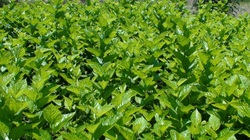|
Hey everyone!
Sorry to have been so remiss in updating you all about our work on Coppice Agroforestry! Here is a little piece about what I’ve been focusing on to keep your appetites whetted. I have been working on the coppice species database, along with my friend Daniel Plane. We have amassed a large quantity of information on a growing number of species—currently 593 mostly-temperate trees and shrubs. We have researched the ecological characteristics (size, form, habit, site tolerances and preferences, behaviors, etc.), timber uses and qualities (wood uses, durability, hardness, specific gravity, color, shrinkage potential, etc.), basketry potential, and medicinal uses (parts used, actions, indications). We have the barest of beginnings of research on edibility of these species, and we intend to do a thorough search of ethnobotanical literature for that information, but also to see how the native Americans used these species, since they were more likely to be using small diameter wood than timbers. Every time we turn to a new arena of research, we find species we add to the database, so we have about half of the species without all the previously researched data filled in! This database alone is a huge project, but the result will be quite useful trove for folks to pull info from. We expect to prune and thin the number of species as we go back to fill in the gaps, depending on their characteristics and how much data we can get for each one, but we still find ourselves in the expansion phase of database creation. Soon, though, we hope to enter the consolidation phase, then the pruning phase, and then the final formatting and editing after that. We have also embarked on an ambitious project of deep scientific literature review to seek data on the use of these species as fodder for livestock. I have already found over 65 papers from around the world documenting the nutritional value of some species for livestock. However, not all of these papers are that useful to us. Some are poorly designed studies, some deal with species of lesser or little interest for this book, some are too narrowly focused to offer us much more than leads to other papers in their reference sections. However, we will persist, as we have yet to follow many leads we have discovered so far. One thing I wanted to turn your attention to on this score is the following website: http://www.fao.org/WAICENT/FAOINFO/AGRICULT/AGA/AGAP/FRG/MULBERRY/DEFAULT.HTM This set of UN Food and Agriculture Organization pages has a bunch of papers from around the world on the use of mulberry as animal forage. The results published in these papers and posters are pretty phenomenal! If it were only one study, they would be hard to believe, but time and again, in different countries and with different researchers, white mulberry (Morus alba) turns out to be an amazing fodder plant. This species can produce yields of 8,000-11,000 pounds of forage per acre (all in the tropics; the highest documented yield: 35,000 pounds per acre!), with the leaves being nutritious and highly palatable to cattle, sheep, goats, pigs, rabbits, chickens and silkworms. The crude protein content of white mulberry ranges in these studies from 15% to 28% (compared to 13% for alfalfa hay!). This species will coppice, it will pollard, you can probably shred the foliage from the trunk and have it regrow. It does need a lot of fertilizer to achieve such yields, but Italian researchers have shown that growing mulberry with subterranean clover makes a huge difference in yield without fertilizer. And you can plant pollard trees in your grass pasture and actually INCREASE the pasture productivity due to cooler temps in the grass! So this is but one slice of what we are up to, and probably the one web page with the most useful and mind-blowing information we have found so far on coppice-able fodder crops. We need people in the temperate areas of the world to play with this species, among many others, to see how it performs in our climates and soils. We also need some help on this project! The fodder research, in particular, is very time consuming and not yielding a lot of data for the time put in, at least yet, but we are determined to do the best effort possible to gather the most data we can. If anyone out there wants to help do some of the literature searching, we need people to search for various strings of search terms on Google Scholar—and ideally at University libraries with good academic search engines and article access—for every species we have in our database! If you are willing to put in a few or many hours doing this work, please get in touch with us at [email protected]. We are also still accepting donations to support this work. You can mail checks to Dave Jacke at 308 Main St. #2C, Greenfield, MA 01301. We will honor the same schedule of rewards as posted on our Kickstarter page. Thanks so much for your support and interest! We look forward to hearing from you and getting this critical information to you in what we hope will not be the too-distant future!
3 Comments
|

 RSS Feed
RSS Feed